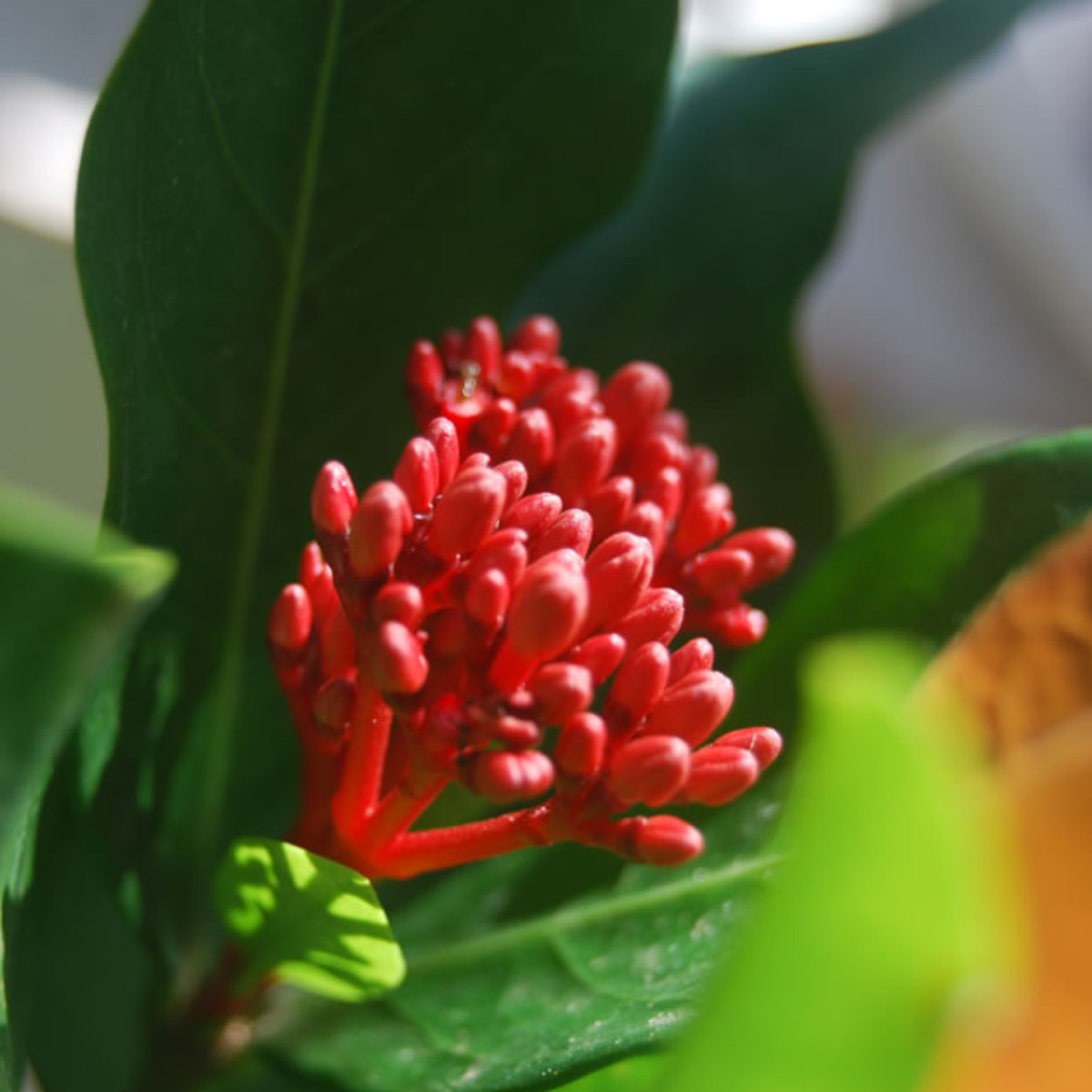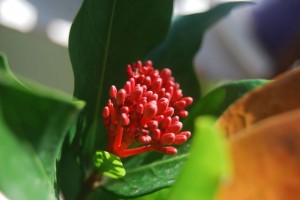Family: Rubiaceae
Synonymous: Ixora grandiflora
Ixora bandhuca
Ixora arborea
Ixora eekhautii
Ixora fraseri
Ixora incarnata
Ixora lutea
Ixora montana
Ixora morsei
Ixora obovata
Ixora propinqua
Ixora purpurea
Ixora shawii
Ixora thomeana
Pavetta bandhuca
Pavetta incarnata
Pavetta rubra
Distribution and habitat: Ixora coccinea is a common flowering shrub native to Southern India and Sri Lanka and widely cultivated in Indonesia, Malaysia, the Philippines, Vietnam, Cambodia, Laos and Thailand. It has become one of the most popular flowering shrubs in South Florida USA gardens and landscapes.
It grows in tropical areas with in medium annual rainfall in well drained soils.
Description:Ixora coccinea is a low-growing tropical shrub notable for its bright coloured flowers which are composed of many small blooms massed together into dense, flat-topped flower heads.Ixora coccinea isone of the few Ixora species that make good indoor plants along with several kinds developed from it.
It takes up to five years for Ixora coccinea to grow to its maximum height of about 1.2m (4 feet). It is a much-branching shrub, with leathery, shiny, pointed oblong leaves up to 10cm (4 inch) long and 5cm (2 inch) wide arranged in pairs or whorls of three or more in 1-2cm (0.4-0.8 inch) long stalks. Leaf colour is dark green, often bronzish when the leaves are new. Tubular flowers, which are up to 5cm (2 inch) long and fiery red, open at the month into four petals arranged in the form of a cross about a centimetre (0.4 inch) wide. The entire flower head has a diameter of 8-12cm (3-5 inch). Normal flowering period is summer, but occasional flowers also appear in the autumn.
Various kind of Ixora which have Ixora coccinea as a parent produce differently coloured blooms, chiefly in shade of orange, yellow and pink, as well as red.
Houseplant care: These plants cannot tolerate much variations from ideal growing conditions and so they are generally grown in glasshouses. However, Ixora coccinea that thrives will repay careful treatment.
Light: Ixora coccinea must have at least four hours a day of direct sunlight.
Temperature: Warmth is essential. These plants cannot tolerate temperatures below 15C (59F). For extra humidity, stand the pots on trays of moist pebbles during the active growing period, but do not continue this treatment during the winter rest period.
Water: Water moderately during the active growth period, allowing the top centimetre (0.4 inch) or so of the potting mixture to dry out between waterings.
During the rest winter period give only enough water to keep the mixture from drying out.
Fertilising: Apply standard liquid fertiliser every two weeks during the active growth period only.
Poting and repoting: Use an equal-parts potting mixture of peat moss, leaf mould and coarse sand or perlite. Move the plants into pots one size larger each spring until maximum convenient pot size (probably 15-20cm (6-8 inch)) has been reached. Thereafter, top-dress Ixora coccinea each spring with fresh potting mixture.
Propagation: Propagate Ixora coccinea from stem cuttings 5-8cm (2-3 inch) long taken in spring. Trim each cutting immediately below a leaf, remove that leaf and dip the cut end in hormone rooting powder. Plant the cutting in a 5-8cm (2-3 inch) pot containing a moistened equal-parts mixture of peat moss and coarse sand or perlite. Enclose the whole in a plastic bag or propagating case and stand it in bright filtered light at a temperature of 21-27C (70-81F). When the cutting has rooted - probably in four to six weeks - uncover it gradually over a two or three weeks period in order to acclimatise the new plant to the less humid atmosphere of the room. When the new plant is fully uncovered, begin to water moderately (allowing a couple of centimetres (0.4-0.8 inch) or so of the potting mixture to dry out between watering again) and apply standard liquid fertiliser once every two weeks. About three months after the start of the propagation move the new plant into a slightly bigger pot of the recommended potting mixture for adult plants and treat it as mature.
Problems:
Ixoras that do not bloom are not getting enough light.
Treatment: Place the plant near a bright window or move it outdoors for the summer.
If the leaves get brown edges and flower buds shrivel without opening, the air is too dry.
Treatment: Put the pots of Ixora coccinea on trays with moist pebble or use a room humidifier to increase the air humidity.
Note: Ixora coccinea is a showy relative of the coffee plant. Both are in the Rubiaceae family.
Uses: It is primarily ornamental plant. Cut specimens are long lasting and are often used in floral arrangements. It is sometimes used as a hedge. In tropical Asia the flowers, bark and leaves of this plant are used in traditional medicine.
It is used for accent plants in planters and as an indoor potted plant. This species may also be shaped into bonsais.
Recommended varieties:
Ixora coccinea 'Fraseri' has attractive salmon pink flowers.
SUMMARY:
CHARACTERISTICS:
Foliage green
Shape upright
Features - flowers
Height: 1.2m (4 feet)
PROPER CARE:
Watering in rest period sparingly
Watering in active growth period moderately
Light direct
Temperature in rest period min 16C max 24C (61-75F)
Temperature in active growth period min 16C max 27C (61-81F)
Humidity high
Hardiness zone: 10-11






